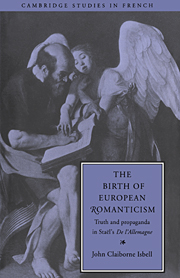Book contents
- Frontmatter
- Contents
- Acknowledgements
- List of abbreviations
- Author's note
- Introduction
- 1 Birth of a nation – Staël's Romantic Germany in 1810
- 2 Romantic literature and politics
- 3 Philosophy and ethics in Napoleonic Europe
- 4 Religion, love, enthusiasm – a new Enlightenment
- Conclusion
- Appendix: De l'Allemagne titles and dates
- Notes
- Bibliography
- Index
- Cambridge Studies in French
Introduction
Published online by Cambridge University Press: 23 September 2009
- Frontmatter
- Contents
- Acknowledgements
- List of abbreviations
- Author's note
- Introduction
- 1 Birth of a nation – Staël's Romantic Germany in 1810
- 2 Romantic literature and politics
- 3 Philosophy and ethics in Napoleonic Europe
- 4 Religion, love, enthusiasm – a new Enlightenment
- Conclusion
- Appendix: De l'Allemagne titles and dates
- Notes
- Bibliography
- Index
- Cambridge Studies in French
Summary
The sciences have always owed their origin to some great spirit. Smith created political economy; Linnaeus, botany; Lavoisier, chemistry; and Madame de Staël has, in like manner, created the art of analyzing the spirit of nations and the springs which move them.
Blackwood's Edinburgh Magazine, 4 (December 1818), p. 278Francis Jeffrey of the Edinburgh Review was arguably the most prestigious critic in the English-speaking world in the first two decades of the nineteenth century. In September 1818, he called Mme de Staël ‘the most brilliant writer that has appeared in our days’. In the age of Wordsworth and Byron, Goethe and Chateaubriand, the remark may seem shocking to modern eyes. But that brief judgement can be better situated through the words of the novelist Fanny Burney, when she first read De l'Allemagne: ‘Such acuteness of thought, such vivacity of ideas, and such brilliancy of expression, I know not where I have met before. I often lay the book down to enjoy for a considerable time a single sentence. I have rarely, even in the course of my whole life, read anything with so glowing a fulness of applause.’
In Romantic Europe, Staël's fame needed no introduction. And her works, now emerging from recent neglect, also directly touch our modern world: what do we mean, after all, by Romantic literature and civilisation? Literature itself is only a fraction of this vast panorama.
- Type
- Chapter
- Information
- The Birth of European RomanticismTruth and Propaganda in Staël's 'De l'Allemagne', 1810–1813, pp. 1 - 9Publisher: Cambridge University PressPrint publication year: 1994



